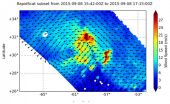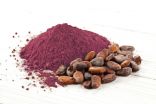NASA's RapidScat looks at Tropical Storm Henri's winds
2015-09-10
(Press-News.org) NASA's RapidScat instrument analyzed the sustained surface winds of Tropical Storm Henri on Sept. 8 as the storm was intensifying.
When the International Space Station flew over Tropical Depression 8 in the Eastern Atlantic Ocean on September 8 at 1p.m. EDT, NASA's RapidScat instrument aboard captured data on the storm's surface winds. RapidScat showed that there were tropical-storm-force winds north and east of the center near 27 meters per second (60.4 mph/97.2 kph). However, sustained winds on the west and southwestern quadrants were near 12 meters per second (26.8 mph/43.2 kph) or less.
At 11 p.m. EDT that night, Tropical Depression 8 intensified and became a tropical storm and was renamed Henri.
By 11 a.m. EDT (1500 UTC) on September 10 the center of Tropical Storm Henri was located near latitude 32.6 North, longitude 60.8 West. Henri is centered about 235 miles (375 km) east of Bermuda and 1,065 miles (1,700 km) south-southwest of Cape Race, Newfoundland, Canada.
Henri was moving toward the north near 9 mph (15 kph) is expected to continue in that direction and speed up through September 11. Maximum sustained winds were near 40 mph (65 kph) and some strengthening is forecast during the next 48 hours. The estimated minimum central pressure is 1008 millibars.
Henri may have just intensified into a tropical storm, but it's facing challenges. Southwesterly vertical wind shear and dry air were limiting the amount of thunderstorm development near the storm's center on September 10.
On September 10, satellite data from NOAA's GOES-East satellite showed the cloud pattern of Henri remains disorganized with most of the convection sheared off to the east and northeast of the center.
The National Hurricane Center expects that wind shear to ease as Henri moves over warm water, giving it the opportunity to strengthen in the next day or two before weakening again.
INFORMATION:
[Attachments] See images for this press release:


ELSE PRESS RELEASES FROM THIS DATE:
2015-09-10
September 10, 2015 (Washington) - There are substantial differences among Americans when it comes to knowledge and understanding of science topics, especially by educational levels as well as by gender, age, race and ethnicity, according to a new Pew Research Center report.
The representative survey of more than 3,200 U.S. adults finds that, on the 12 multiple-choice questions asked, Americans gave more correct than incorrect answers. The median was eight correct answers out of 12 (mean 7.9). Some 27% answered eight or nine questions correctly, while another 26% answered ...
2015-09-10
DOWNERS GROVE, Ill.-- September 10, 2015--Having patients lie on their left side while the right side of their colon is being examined can result in more polyps being found, thus increasing the effectiveness of colonoscopy for colorectal cancer (CRC) screening, according to a study in the September issue of GIE: Gastrointestinal Endoscopy, the monthly peer-reviewed scientific journal of the American Society for Gastrointestinal Endoscopy (ASGE).
CRC is one of the most common cancers in the US and other western countries. Studies have shown that deaths from CRC are reduced ...
2015-09-10
Two recently published studies in the journals Age and the British Journal of Nutrition (BJN) demonstrate that consuming cocoa flavanols improves cardiovascular function and lessens the burden on the heart that comes with the ageing and stiffening of arteries. The studies also provide novel data to indicate that intake of cocoa flavanols reduces the risk of developing cardiovascular disease (CVD).
As we age, our blood vessels become less flexible and less able to expand to let blood flow and circulate normally, and the risk of hypertension also increases. Arterial stiffness ...
2015-09-10
This news release is available in German. Protein labeling with synthetic fluorescent probes is a key technology in chemical biology and biomedical research. The target proximity achieved by small-molecule probes is essential to exploit the full potential of super-resolution fluorescence microscopy. Single-molecule localization techniques provide high spatial resolution by reporting on the position of the fluorophore and thus only indirectly on the target molecule itself. Large labels, such as antibodies, can misleadingly position a fluorophore tens of nanometers away ...
2015-09-10
An international research team, which includes NYU anthropologists Scott Williams and Myra Laird, has discovered a new species of a human relative. Homo naledi, uncovered in a cave outside of Johannesburg, South Africa, sheds light on the diversity of our genus and possibly its origin.
"This discovery is unprecedented in the sheer number of hominins collected from such a small area in the virtual absence of other animal remains," says Williams, an assistant professor in NYU's Department of Anthropology. "That makes this site unique. Moreover, the announcement describes ...
2015-09-10
Bethesda, MD (Sept. 10, 2015) -- Detection of small fragments of tumor DNA, known as circulating tumor DNA, in a patient's pre-surgery serum samples predicts early recurrence of hepatocellular carcinoma and may guide treatment, according to a study1 published in Cellular and Molecular Gastroenterology and Hepatology, the basic and translational science journal of the American Gastroenterological Association. Hepatocellular carcinoma -- the most common type of liver cancer -- is the third leading cause of cancer deaths worldwide.
"We uncovered that circulating tumor DNA ...
2015-09-10
The steps involved in evaluating and diagnosing patients with epilepsy are complicated. In a new and extensive literature review of available information, experts provide insights on the valuable role of genetic testing in the diagnosis and care of pediatric epilepsy.
Epilepsy is a common neurological disorder that affects up to 1.5% of the world's population and is more commonly diagnosed in children than adults. Most cases of epilepsy have been considered "idiopathic" or of unknown cause, but recent advances in genetic testing are providing insights on the potential ...
2015-09-10
In a modern, multicore chip, every core -- or processor -- has its own small memory cache, where it stores frequently used data. But the chip also has a larger, shared cache, which all the cores can access.
If one core tries to update data in the shared cache, other cores working on the same data need to know. So the shared cache keeps a directory of which cores have copies of which data.
That directory takes up a significant chunk of memory: In a 64-core chip, it might be 12 percent of the shared cache. And that percentage will only increase with the core count. Envisioned ...
2015-09-10
MADISON, Wis. -- Working in a cave complex deep beneath South Africa's Malmani dolomites, an international team of scientists has brought to light an unprecedented trove of hominin fossils -- more than 1,500 well-preserved bones and teeth -- representing the largest, most complete set of such remains found to date in Africa.
The discovery of the fossils, cached in a barely accessible chamber in a subterranean labyrinth not far from Johannesburg, adds a new branch to the human family tree, a creature dubbed Homo naledi.
The remains, scientists believe, could only have ...
2015-09-10
Bethesda, MD (Sept. 10, 2015) --All colorectal cancer patients should undergo tumor testing to see if they carry Lynch syndrome, the most common inherited cause of colorectal cancer, according to a new guideline1 published in Gastroenterology, the official journal of the American Gastroenterological Association.
"Approximately 50,000 Americans are expected to die from colorectal cancer this year, and hereditary syndromes account for a small, but important fraction of those diagnoses," said Joel H. Rubenstein, MD, AGAF, lead author of the guideline, research scientist ...
LAST 30 PRESS RELEASES:
[Press-News.org] NASA's RapidScat looks at Tropical Storm Henri's winds



